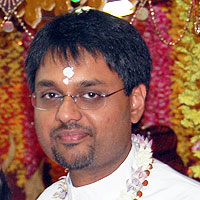From a satsang with Pt. Dr. Umesh Persad, Spiritual Leader, Shiva Shakti Mandir of Marion Oaks, Fla.
Ganesh Jayanti marks the sacred occasion of Bhagavan Ganesh’s ‘birth’ or appearance in the earthly realm; it is a time of profound spiritual significance. We then observe Ganesh Utsav, a period dedicated to the special worship of Lord Ganesh, in which rituals, mythology and philosophical teachings guide us on our spiritual journey.
The Essence of Ganesh Worship
In the practice of Sanaatan Dharma, we acknowledge one supreme, intangible Consciousness, referred to as Brahman. Everything we perceive in creation is a manifestation of the singular Brahman, a cosmic play of one unified reality. However, we do not recognise this truth, living in a state of ignorance where we see ourselves as distinct individuals rather than part of a larger whole. In Sanaatan Dharma, the various forms of God, including Ganesh, are personifications of higher principles meant to guide us toward self realisation.
Lord Ganesh is known as the remover of obstacles and the Lord of all Ganas—or followers, on one level. The term ‘Gana’ in Sanskrit also represents categories or classes, reflecting how we label and divide the world around us. At a deep level, Lord Ganesh teaches us to see beyond these divisions, to perceive everything as interconnected, and to recognise the same consciousness in all beings. This right vision, symbolised by Ganeshji, is the ability to see things as they truly are in reality, transcending categorical thinking.
When we worship Lord Ganesh and chant His stotras, we awaken within ourselves the power to perceive our challenges with clarity and find solutions from within. The story of Ganesh’s appearance holds profound symbolic meaning, especially in the context of spiritual growth.
The Symbolism in Ganesh’s Katha
In the story of Ganeshji’s creation, Parvati Devi, representing the universal energy or Shakti, crafts a child from the dirt of her body and breathes life into him. This symbolises the energy of the universe manifesting as individual beings. Ganeshji is instructed by his mother to guard her privacy, and in doing so, he encounters Bhagavan Shiva, who, unaware of the child’s identity, beheads him in a moment of anger with his trishul (trident). This act, and the subsequent revival of Ganeshji with an elephant’s head, is deeply symbolic.
The beheading by Shiva’s trishul represents the removal of ignorance and the dissolution of the ego. The trishul itself, with its three prongs, symbolises the three forms of suffering—physical, mental and spiritual—that must be overcome to attain higher knowledge. To solve our problems, we must metaphorically “cut off” our own heads, meaning we must let go of our ego and limited self-perception.
Ganeshji’s new head, the elephant’s head, signifies wisdom and the true sense of self. This transformation represents a shift from ignorance to the realisation of our cosmic identity, where we see ourselves as part of the greater whole—”Tat Twam Asi” (Thou Art That). This union of the human body and the elephant’s head embodies the principle of Shree Ganesh, where wisdom and right vision lead to the understanding of our essential cosmic nature.
Applying Ganesh’s Teachings to Our Lives
To embody the wisdom of Ganesh, we must engage in three spiritual practices that guide us towards self-realisation. These include:
– Guru: The teacher who dispels the darkness of ignorance.
– Scripture: The sacred texts that provide the knowledge necessary for spiritual growth.
– Inner Guru: The awakened intellect within, which helps us discern truth and see things from the right perspective.
Spiritual life is supported by three key methods: contemplation, prayer and meditation. Contemplation involves deep reflection on our true nature and the teachings of the scriptures. Prayer begins with seeking assistance from the Divine but evolves into surrender to the Divine, acknowledging that we do not see the full picture of existence. Meditation, the final practice, is the art of abiding in our natural state of stillness and calm, even amidst life’s turbulence.
When we “cut off our head” in the spiritual sense, we remove the false sense of self and embrace the wisdom of Ganeshji—the true vision of our cosmic identity. The elephant head of Ganesh, representing wisdom and the cosmic eye, serves as a reminder that our ultimate goal is to realise and embody the Ganesh principle, moving beyond ritual to the full experience of who we are. In this journey, Lord Ganesh is our guide, leading us with right vision and the power of discernment.



